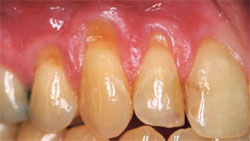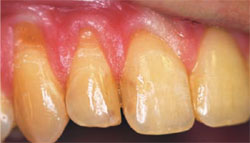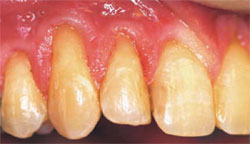The Paste Pak Cartridge: A Convenient and Dependable Dispensing System
Randy Weiner, DMD
We face many demands and many challenges. These include collections, broken appointments, staffing, and choosing the right materials and restorative techniques, just to name a few. Fortunately, we have some help in dealing with these challenges. When it comes to deciding which material and which technique is best, help comes from the dental manufacturers.
It would be much less stressful to the dentist and the staff if the materials and the techniques used were both patient friendly and user friendly. Patient friendly implies that the patient would be asymptomatic after treatment, pleased with any esthetic aspects of the treatment, and would be encouraged to return and completing the remainder of the treatment plan. User friendly would mean that the material would be easy to use, clean up, store, and it would not be technique sensitive or overly expensive. In 1998, The Dental Advisor, in an issue about temporary cements, concluded that, ideally, material kits should be compact with minimal waste and the material should not continue to flow after the desired amount is dispensed.1
There are many companies that have products that can be classified as both patient and user friendly. One such company, GC America (Alsip, IL), has afforded us with a number of products that can be categorized as such. To make things even more user friendly, GC America has provided that five of their products (GC Fuji LINING™ LC, GC Fuji Filling™ LC, GC FujiCEM™, LINKMAX™, and Fuji Ortho Band) be available in what they call the Paste Pak Dispenser. The Paste Pak Dispenser is a metallic instrument into which a cartridge is inserted. The dual-chamber cartridge contains the desired material, and the dispenser allows for an efficient delivery of the pastes. A “metering slide” on the dispenser’s lever allows the operator to regulate the volume of extruded material, thereby reducing waste.2 This slide is a simple plastic piece that controls the amount of material being dispensed by controlling the range of motion of the handle. Think of it as a door stop; the closer the hinge, the less material that is expelled, the further the hinge, the more material that is extruded. The Paste Pak dispenser allows for an ideal mixing ratio to be achieved. It also prevents incorporating bubbles into the mixture (as is possible with powder-liquid formulations). The Paste Pak is advantageous especially when it is to be handled by inexperienced staff and it also allows for a sustained shelf life. All five of the Paste Pak products can be used with the same dispenser, thus allowing the dental office to reduce the costs of supplies. Additionally, the metal dispenser is easily sterilized.
GC FUJI LINING LC
GC Fuji LINING LC is the first light-cured glass-ionomer lining material available in a paste-paste formula and was introduced in 2002. It has a high compressive strength (194 MPa at 24 hours), minimal polymerization shrinkage, and low solubility. GC Fuji LINING LC, like all glass ionomers, has a thermal expansion similar to tooth structure, which allows it to flex (low modulus of elasticity) and absorb stresses placed on it by polymerization shrinkage and the contraction of composite materials that are placed above it as a final restorative material.
GC FUJI FILLING LC
The newest member the Paste Pak group of products is a resin-reinforced, glass ionomer (RRGI) restorative material that can be used not only as a final filling but also as a base. When used as a final restoration, it is best suited for Class III and Class V lesions. GC Fuji Filling LC comes with a self-conditioner. This no-rinse conditioner allows the adhesion with the tooth to be stronger and more stable. It is applied to the cavity preparation and left undisturbed for 10 seconds, at which time the material is subjected to drying by using a gentle stream of air until the surface appears glossy. After drying the filling is placed and cured. Operators will find that application will be easier if the material is placed in a Centrix-type (CR) tip. GC Fuji Filling LC comes in five tooth-colored shades (matching the Vita® shade guide) and a blue shade. The working time of the product is about 3.5 minutes and it light-cures in 20 seconds. As with other glass ionomers, this material allows for the leaching out of fluoride. The amount of fluoride contained in this material is substantially higher than other RRGIs.
The clinical case shown is from a 34-year-old man with moderate to severe gingival recession and the associated abfraction of teeth Nos. 5 through 7 (Figure 1). Figure 2 shows the prepared teeth with a small retentive undercut at the incisal edge of the lesion as well as a bevel on the enamel in this area. These teeth have been restored with GC Fuji Filling LC Shade A2 (Figure 3).
As mentioned previously, this product also is ideal as a basing material. The clinician will find it easier to use GC Fuji Filling LC as a base if it is allowed to sit for approximately 5 seconds after mixing and prior to placement in the cavity preparation. Doing so will reduce some of the tackiness of the mixture and allow for easier condensation. When a base is needed under a metallic restoration, the blue version of GC Fuji Filling LC is appropriate. This will allow the operator to distinguish between the restorative material and the underlying dentin should it be necessary to reenter the cavity preparation.
Dentists should be aware that GC Fuji Filling LC and GC Fuji LINING LC can be used to cover exposed dentinal surfaces in an emergency situation. For example, should a small piece of a cusp fracture off a tooth and an indirect restoration is treatment planned at another visit, the exposed dentin can be protected in the interim by placing a glass ionomer over it. Because GC Fuji Filling LC is available in a number of shades, it may be better suited for this application.
GC FUJICEM
GC FujiCEM is a RRGI luting agent. It also was the first one available in a paste-paste formulation. It is chemically similar to GC Fuji Plus (GC America), another RRGI cement that is available in a powder-liquid format (encapsulated product). Although GC FujiCEM can be mixed in as little as 10 seconds, the operator should take up to 20 seconds. This is because both pastes are similar in shade and the extra spatulation will ensure a complete and thorough mixture.
LINKMAX DUAL-CURE RESIN ADHESIVE CEMENT
Made available in 2002, LINKMAX is a dual-cured resin cement that was manufactured for use with all types of dental prostheses. The LINKMAX package contains a self-etching primer to increase the bond to tooth structure. GC America also makes available to the clinician three other primers (ceramic, composite, and metallic), each designed to work with specific substrates. LINKMAX is available in two shades: A3 and clear.
FUJI ORTHO BAND
This RRGI is intended for bonding orthodontic bands as well as for the cementation of appliances that are retained with stainless steel crowns. Those providing orthodontic care will appreciate the blue color, as it will allow the operator to distinguish between the cement and tooth structure during removal and cleanup of orthodontic appliances. A study by Komori and colleagues showed that Fuji Ortho Band released more fluoride than four other conventional glass ionomer cements.3
CONCLUSION
According to the CRA Newsletter, the Paste Pak pre-proportion dispensing of two pastes solves the need for time-consuming repeat mixing and assures optimal consistency and physical properties with no waste.4 Dentists will appreciate this and therefore, have one less stressful aspect of clinical dentistry to worry about.
References
1. Farah J, Powers J. Temporary Cements. The Dental Advisor. 1998;15(9): 2.2. Farah J, Powers J. GC FujiCem. The Dental Advisor. 2001;18: 9.
3. Komori A, Kojima I, Nakahara R. Evaluation of the two paste resin reinforced glass ionomers cement for cementation of orthodontic bands. J Dent Res. 2003:82(Special Issue B):Abstract #1988.
4. Cements, resin reinforced glass ionomers. CRA Newsletter. April 2001;25(4):3.
This article was written by Randy Weiner, DMD.
For More Information
GC America
Phone: 1-800-323-7063
Web: www.gcamerica.com
 |  | |
| Figure 1 Teeth Nos. 5 through 7 before treatment. Note the exposed root surface due to recession. | Figure 2 Minimal preparation of the teeth. | |
 | ||
| Figure 3 Teeth immediately after treatment is completed. |



